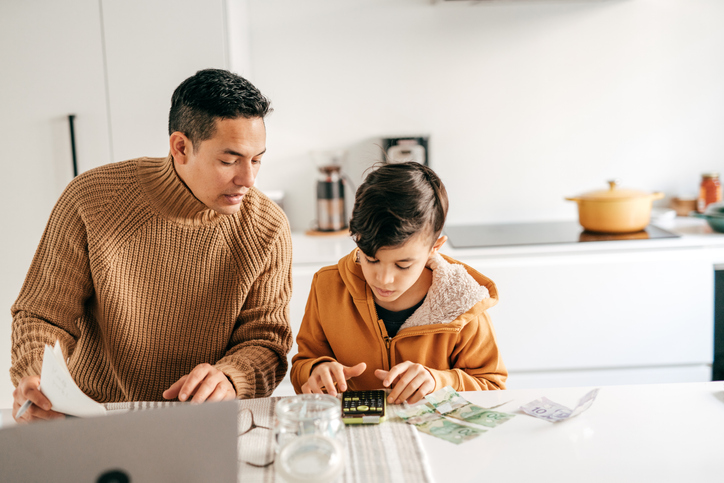Teaching my kids about financial responsibility has always been important to me, but in 2025, it feels more critical than ever. With the rise of digital currencies, subscription-based services, and countless "buy now, pay later" schemes, money is becoming more abstract for younger generations. Here’s how I’ve approached teaching my kids to be financially responsible in a world that’s constantly evolving:
- Start with the basics
I realized that financial literacy starts with understanding the value of money. For my younger kids, we began with simple conversations about what things cost. At the grocery store, for example, I’d ask, “Do you think a carton of milk costs more or less than this loaf of bread?” It’s a fun way to introduce them to the concept of prices and budgeting.
- Digital wallets, explained
Cash is almost nonexistent these days. My kids see me tap my phone to pay for everything from gas to groceries, so I knew I had to explain how digital payments work. I showed them how bank accounts, debit cards, and digital wallets function. We even set up a child-friendly banking app where they can see how much money they have, save for goals, and track their spending. This hands-on experience makes concepts like budgeting more real for them.
- Teaching through allowances
Giving my kids a weekly allowance has been one of the most effective tools for teaching them about money. But it’s not just about handing them cash (or transferring funds to their digital account). I created a system:
- Earn: They help with chores around the house to “earn” their allowance.
- Save: I ask them to put a small percentage of their allowance into savings.
- Spend: They have the freedom to spend what’s left, but they have to think before making impulsive purchases.
- Give: A portion goes toward donations or helping others, teaching them the value of generosity.
- The power of saving goals
My oldest wanted a new gaming console, but it wasn’t cheap. Instead of buying it for him outright, I turned it into a lesson. We sat down and calculated how much he’d need to save each week to afford it. Over time, he got excited seeing his savings grow. When he finally reached his goal and bought the console himself, the look of pride on his face was priceless. It was a powerful way to teach delayed gratification and the reward of saving.
- Introducing investments early
One thing I wish I had learned earlier in life was how investments work. So, I’ve introduced my kids to the basics. We started with simple concepts like stocks and how money can grow over time. I even created a “family portfolio” where we pretend to invest in real companies. My kids get to pick a company they like (based on their interests), and we track its progress together. It’s a fun way to make investing less intimidating.
- Talking about debt
Debt can be a tricky topic, but I believe it’s an essential part of financial education. We’ve talked about what credit is and how borrowing works. I’ve also emphasized the dangers of high-interest debt and the importance of paying off balances on time. To make it relatable, I’ve shared stories from my own experiences with credit cards to help them understand both the benefits and risks.
- The true cost of subscriptions
In 2025, subscriptions are everywhere—streaming services, apps, even monthly snack boxes. I taught my kids to look beyond the monthly fee and think about the yearly cost. For instance, a $10/month subscription might not sound like much, but when you multiply it by 12 months, it adds up. This has helped them think critically before signing up for anything, even free trials.
- Learning through mistakes
I’ve let my kids make small financial mistakes. One time, my daughter spent all her allowance on cheap toys that broke within days. While it was hard to watch her disappointment, it was a valuable lesson. She learned to think twice before spending and now prioritizes quality over quantity.
- Encouraging entrepreneurship
I’ve encouraged my kids to find ways to earn their own money beyond their allowance. My youngest started a lemonade stand last summer, and my oldest has been selling handmade bracelets online. These small ventures have taught them about hard work, pricing, and even marketing.
- Understanding needs versus wants
One of the simplest but most impactful lessons has been teaching my kids to differentiate between needs and wants. We’ve had countless conversations about why we prioritize groceries and bills over toys or gadgets. It’s helped them appreciate the value of money and understand why budgeting matters.
- Staying mindful in a digital age
With in-app purchases and one-click shopping, spending money has become dangerously easy. I’ve taught my kids to pause before making purchases. We’ve implemented a “24-hour rule”—if they want to buy something, they have to wait 24 hours to see if they still want it. More often than not, they realize it wasn’t worth it.
- Leading by example
Kids learn a lot by watching their parents. I make an effort to talk openly about our family budget, savings goals, and even the tough financial decisions we’ve had to make. By being transparent, I’m showing them that money management is an ongoing process, not something to be afraid of.
Teaching my kids about financial responsibility has been a journey, but it’s one of the most rewarding things I’ve done as a parent. The world they’re growing up in is vastly different from the one I knew, but the core principles of earning, saving, and spending wisely remain the same. My hope is that these lessons will empower them to navigate their own financial futures with confidence.


